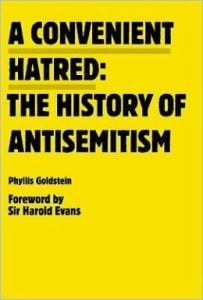Michael Grover
Teacher
Scarborough Centre for Alternative Studies
Scarborough, ON
Michael Grover
Recent Posts
Topics: History, Strategies, Lesson Ideas, English Classroom
- A Convenient Hatred: The History of Antisemitism, by Phyllis Goldstein
This a wonderful resource from Facing History, but the fact that it is a Facing History resource is not the reason I include this book. Goldstein’s A Convenient Hatred provides a detailed explanation of the history of antisemitism and how it has adapted and persisted through time. This book has been an invaluable resource to me in helping to answer that recurring question: “Why did [they] hate Jewish people?” In fact, if I once had trouble answering that question, I now have troubling keeping my answer to that question to an accessible chunk.
As a classroom resource: the book is extensive in its purview of the subject and can be, as such, integrated into almost any history course (from ancient to modern studies). Moreover, being a Facing History publication, there are numerous resources available for using the book in the classroom. Of particular worth, I would advise taking a free online workshop associated with the text. The next begins March 15, 2013. - The Rape of Nanking: The Forgotten Holocaust of World War II, by Iris Chang
In The Rape of Nanking Iris Chang provides not only a detailed account of the events and their context, but she also offers a profound explanation for the motivation of the Japanese soldiers during the invasion of China. This book graphically details the horrors of human behaviour, broadens our understanding of World War II, demonstrates the effects of unchecked institutionalized discrimination, and details the politics of denial.
As a classroom resource: the writing is accessible intermediate academic and senior academic and applied readers. Of particular note for use in the classroom are Chang’s explanation of the profound effect of institutionalized discrimination on the behaviour of individuals (see “The Motives Behind Nanking,” pp. 54-59 and the classroom reading guide), and Chang’s address of the continued denial(see Chapter 10) of the event by the Japanese and the politics surrounding our ignorance of it in the West, a relevant theme to all discussions of genocide. The book includes graphic documents (primarily but not limited to photographs found between pages 146 and 147) of the atrocities that are incredibly thought provoking for mature students, but must be very carefully selected and reviewed with consideration to students’ capacity to deal with them (and the parents willingness to have them viewed by their children). It is worth noting that the stories and images Chang encountered while writing this book led her into increasingly deeper depression and, eventually, to suicide; this knowledge serves as a profound reminder that as we deal with human atrocities, we must consider and allow time to address our students’ own emotional reactions to these events. Iris Chang gives a historical overview and shares her insights into the Japanese military invasion of Nanking at http://vimeo.com/21218528.
- Extraordinary Evil: A Brief History of Genocide, by Barbara Coloroso
If Coloroso’s Extraordinary Evil can be described as reductionist in its approach to and description of genocide vis a vis bullying, it can nonetheless also be conceived of as a wonderful resource for teachers of genocide to help students connect with material that can be so difficult to conceptualize. Coloroso’s writing is accessible to high school students and the connections she makes are directly relevant to the school context. She makes a point of discussion and an argument for understanding how our actions matter, even on a small scale. She makes an excellent argument for the role of the upstander (Facing History defines an upstander as someone who takes a stand against injustice), and why that role is not one that should be conceived of as a contextual one, but rather a pervasive attitude and behaviour.
As a classroom resource: her discussion of the Bully Circle (pp. 83-84) is interesting and one that I have found helps students develop empathy. While few students can truly connect with the tragedy of a genocide, almost all students can relate to bullying. Having students make this connection (see page four of the activity attached for classroom application) through role play can be very effective, but, as always, we must know our class. If we suspect someone in the class is being bullied, having that person participate could be incredibly demeaning. Furthermore, in the consolidation of our role play, it would be good to emphasize that just because we can empathize with being bullied, does not mean we can (nor do we want students to) fully understand what it means to be a victim of a genocide. Role play is fun and develops empathy. Just make sure it remains role play! Coloroso’s website provides additional resources for discussing roles in bullying at KidsAreWorthIt.com. - War Without Mercy: Race and Power in the Pacific War, by John Dower
In War Without Mercy, Dower takes a close look at World War II and compares the nature of racism and warfare in the two primary theatres of the war: the European theatre and the Pacific theatre. In analyzing various data, he quickly notes that [for the Americans] the battles in the Pacific were far more brutal than those in Europe. Building on this, he argues that while in the European theatre there was a sense of shared humanity even between opposing soldiers, the racist attitudes that soldiers in both Japan and America were taught (and taught is the key word here) regarding the enemy heavily influenced the subsequent treatment of the enemy. Dower focuses on the media’s role (through songs, propaganda, cartoons, and film) and influence in propagating racist attitudes. Though the language of the text is at times a bit too academic for the applied classroom in which I teach, his discussion of the media’s influence over how we think and behave is an accessible and worthy topic to engage in the classroom.
As a classroom resource: while I find the text is a bit dense, Dower includes a wonderful section of very accessible graphic documents such as magazine cartoons that very clearly depict “The War in Western Eyes” and “The War in Japanese Eyes”(pp. 180-200). Students engage with these quickly and with facility, and the documents provide a wonderful opportunity to teach students Document Based Questions, an important skill to develop and an imperative for the AP classroom (see image guide handout for classroom use). As a springboard to further inquiry, there is a wealth of related documents readily available to review as well. In particular, Merrie Melodies / Loonie Toons’ "Censored Eleven" (see video guide handout for classroom use) provide a unique insight into how stereotypes and racist ideas are taught to even the youngest audiences, though one should use discretion in approaching these documents in the classroom. Always contract for a safe space, provide students with context, explain your purpose and allow sufficient time to debrief challenging materials. Also, be ready to provide victim voices and positive depictions to balance negative portrayals of any identity. Lastly, know your students and their parents. - Cognitive Surplus: How Technology Makes Consumers into Collaborators, by Clay Shirky
While Shirky’s Cognitive Surplus does not directly address the issues of genocide or discrimination, this text is a wonderful resource for transforming our students from passive recipients of information to active upstanders, and can guide us as teachers through this process. Shirky details how the rise of the computer and the internet in the 21st Century has dramatically changed how people engage media. His key point, as the title suggests, is that people have demonstrated a measurable change in their patterns as consumers, moving away from a model of passive recipients of media products (e.g. television) to one of active producers (an amusing example he points to is LOL Cats). Shirky lists several examples (moving beyond LOL Cats) of how this shift in the control of production means that as individuals, we now have more control to produce good than at any point in history.
As a classroom resource: the first example Shirky lists to this end is Ushahidi, a site whose name means ‘testimony’ or ‘witness’ in Swahili. This is a web based program that has relied on the contribution of volunteers to spread awareness of events. Designed during the social upheavals in Kenya in 2007-2008, Ushahidi demonstrated a huge influence over political behaviour, and was operated at an individual level (for further information see Texting Talk). Ushahidi is a wonderful example of how individuals can be upstanders, and how as upstanders they can effect change. Jumping off from Ushahidi, we can explore other Web 2.0 tools (such as Glogster, Prezi, Bubbl.us, etc.) to produce our own multimedia products, use social networking sites (such as Facebook, My Space, Google+, etc) and employ online publishing tools (Wordpress… ironic emoticon here) to effect social change. Other prominent examples of sites dedicated to the harnessing of positive collaborative power include Change.org, DonorsChoose.org and Kickstarter.com.
For a succinct review of the book, see Shirky’s TED Talk on Cognitive Surplus.
Topics: Books, Professional Development
Topics: Strategies


